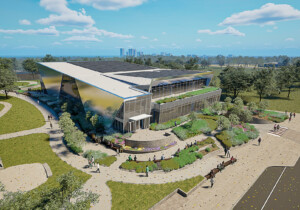Robert A.M. Stern took a moment to speak with AN Midwest Editor Matthew Messner about One Bennett Park, Stern’s first tower in Chicago. In part thanks to a long, trusting relationship with the developer Related Midwest, Stern’s office, Robert A.M. Stern Architects, was tasked with designing both exterior and interiors for the project. Design partner Daniel Lobitz is leading a team to design a tower that Stern hopes will capture some of the glamour of old Chicago.
The Architect’s Newspaper: What do you see as some of the advantages of being able to control so much of the design?
Robert A.M. Stern: I think an architect who has a strong sense of design can create almost anything, and certainly should be able to, and should be encouraged to, carry the design ideas into the interior. Certainly the public areas—lobby, elevators, cabs, and public halls—on any floor in a residential building. We have done that in many buildings and for many of our buildings for Related in New York, including the Chatham, the Brompton, the Harrison, Tribeca Park, Tribeca Green, and most recently, 261 Hudson Street. Can you imagine a Mies van der Rohe building, whether his apartments on the Lake Shore or his office buildings, not being designed by Mies on the inside? I can’t. If you don’t trust an architect to design the inside of the building, why trust them to design the outside of the building?
Are there references or motifs that informed the design of One Bennett Park?
I think precedent is a very important factor in the design of this building, but it’s a very important factor in the design of any building we undertake. I would say precedent is not necessarily historic. Precedent also can, and should, incorporate local traditions, local vernaculars of local buildings. This tower is our first tower built in Chicago, and only the second time we have built anything in Chicago. (Except for the bus shelters, and I guess there are 2,200 of them, so that must count for something.) I’ve been visiting Chicago as an archi-tourist for virtually all my life, so I know the great buildings are especially relevant to our work. Some of those buildings include the Marshall Field and Company Building in the Loop, and the Palmolive Building on North Michigan Avenue. A fantastic body of buildings—not only in Chicago, but all across the Midwest and other places as well—that inspired us as we began to think about how to shape the tower. Too many tall buildings are just extensions from the bottom up to the top. They may be structurally encased, like the John Hancock, but it’s fundamentally an extrusion. I prefer—among the modernist buildings in Chicago in relationship to this discussion—what in my mind will always be the Sears Tower; I don’t know what it is called this week. It steps up in the most amazing way according to a structural idea of Fazlur Rahman Khan.
What are some of the interior features of One Bennett Park that you feel make it exceptional?
There is a glamour about some of Chicago’s interiors, residential and not. For example, the lobbies of the Marshall Field Building are wonderful. So, we wanted to capture some of that Chicago glamour in our lobbies. We have two separate lobbies, one for the rental portion of the building, and another for the condominiums. Each has its own design statement. The condominium lobby, which has wood paneling, is traditional, as wood paneling is traditional, but it’s really very stylishly modern as well. There is a visual interest that one associates with buildings of the ’20s and ’30s, and that is sometimes not associated with the buildings of the late 20th century on the whole. We were looking at a lot of Frances Adler Elkins’s work (she was David Adler’s sister).
Has there been any particular advantages, or challenges, about building a major project in Chicago?
Nothing out of the ordinary. I think we are perhaps entering into a new territory of elegance and detail, and all of that costs money. I hope Chicagoans are getting ready to dip into their deep pockets for our building. The truth of the matter is the cost of habitation in Chicago is substantially lower than in New York. To get this much quality, and to really break out of a rather “businesses as usual” mode, is a compliment to our clients, Related Midwest, to stick their necks out. I just hope we don’t get chopped off.










